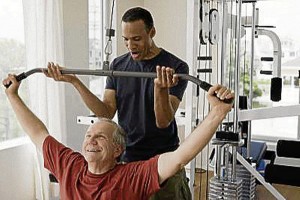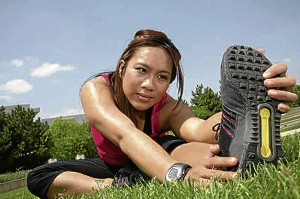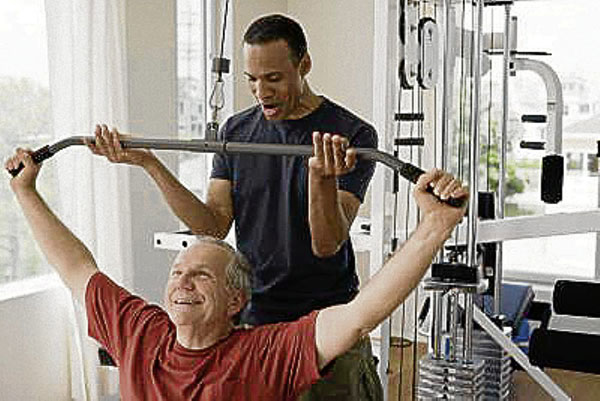 Are you getting confused about the most appropriate amount of aerobic, resistance and flexibility training to complete each week? Are you aware of the difference between a fitness enthusiast and fitness professional? Are you sure your current diet or exercise program is really improving your metabolism?
Are you getting confused about the most appropriate amount of aerobic, resistance and flexibility training to complete each week? Are you aware of the difference between a fitness enthusiast and fitness professional? Are you sure your current diet or exercise program is really improving your metabolism?
This mid-year fitness report will bring answers to beginning and advanced exercisers and fitness consumers.
The latest American College of Sports Medicine (ACSM) guidelines for Apparently Healthy Adults (released June 28) say:
Cardiorespiratory exercises like brisk walking, aerobic dancing should be done for a total of at least 150 minutes a week. Moderate intensity exercise should be done 30-60 minutes, five days a week. Or, complete 20-60 minutes of vigorous-intensity exercise three day a week. One continuous exercise session or multiple short sessions of at least 10 minutes are both acceptable to provide desired results.
Resistance exercises for major muscle groups should be done two or three days a week. Eight to 12 repetitions will improve strength and power; 12-15 repetitions will improve muscular strength for middle-age and older adults starting exercise; and 15-20 repetitions will improve muscular endurance. Sedentary and older adults should start with a light intensity workout.
Flexibility exercises should be done two or three days a week to improve range of motion. Each stretch should be performed to the point of tightness or slight discomfort with 10-30 seconds hold, and must be repeated several times until you accumulate 60 seconds per stretch.
Neuromotor exercise (functional fitness training) should be done 20-30 minutes a day, two to three days a week to improve physical function and prevent falls in older adults. It should involve motor skills (balance, agility, coordination and gait), proprioceptive training and multifaceted training like yoga.
Trainer certifications
According to Amanda Vogel, author of the article “Kournikova On Biggest Loser: Is She Certified?” published in this month’s issue of Idea Fitness Journal, the official publication of the Idea Health and Fitness Association (the world’s largest association for fitness and wellness), 45 percent of fitness professionals falsely claim they are currently certified.
Vogel’s current article about Kournikova (replacing Jillian Michaels) as the newest trainer for NBC’s “Biggest Loser” awakened the issue of professionalism among fitness experts worldwide. The issue of trainer credibility should be emphasized to the general public and fitness consumers to ensure program safety and effectiveness.
Be mindful of the following when you consult with or hire a fitness trainer.
Ask the current certifications of a trainer. Some of the accredited fitness programs by the National Commission for Certifying Agencies (NCCA) are ACSM, American Council on Exercise (ACE), National Academy of Sports Medicine (NASM) and Strength and Conditioning Association (NSCA).
If a trainer tells you that he is certified by ACE in personal training, feel free to check www.acefitness.org, search the trainer’s full name or you can just type the country, and all certified fitness professionals in their designated country, plus their education, experiences and other certifications will appear.
You can also ask about an instructor’s educational background, specialty certifications and training, especially if he or she is teaching Pilates, spinning classes, yoga, and programs for special populations (people with heart problems, orthopedic conditions, etc.)
Vogel mentioned that fitness enthusiasts are familiar with and enjoy exercising, whereas fitness professionals have undergone specialized trainings and are experienced to provide quality fitness services. Responsible fitness professionals update their certifications at least every two years by attending conventions and taking specialty courses, and they do not rely solely on the exercise knowledge they had five or 20 years ago; they make an effort to remain current.
A fitness enthusiast can still be a professional by undergoing education through courses plus certifications, and must experience handling clients with different conditions.
Metabolism makeover
Len Kravitz, researcher and program coordinator of exercise science at the University of New Mexico, restated some issues about metabolism in his recent research article, “Metabolism Make-Over: Fact or Fiction,” published in the June issue of Idea Fitness Journal. 
Diet-only programs can slow down your metabolism by approximately 300 calories per day. But combining diet with exercise (strength and cardio) can preserve your muscle mass and avoid decline in metabolism. This study has been published in the British Journal of Nutrition.
Continuous participation in long-term aerobic exercise (three to five days per week for 20-45 minutes at moderate intensity) like running, dancing or cycling can improve a daily average increase of 129 calories for females and 174 calories for males, according to a 16-month study published in the International Journal of Sport Nutrition and Exercise Metabolism.
Long-term participation in resistance training can improve one’s metabolism by seven percent in just six months, according to a study published in Journal of Applied Physiology.
Bottom line: Balanced diet combined with long-term regular aerobic and resistance training program can increase your calorie burn to as much 200 calories per day, in addition to your existing resting metabolic rate (RMR), which is the total amount of calories your body burns in 24 hours even without doing anything. RMR is influenced by your genes, hormones, gender and activity.
For example, if your RMR is 1,500 calories per day, long-term exercise participation without extreme dieting will give you an additional 100 or more calories per day. It is important to know that RMR is 60 percent of your Total 24-Hour Energy Expenditure, while 30 percent of daily calorie burn comes from your thermic effect of exercise and spontaneous activity, and 10 percent from the thermic effect of food metabolism.
E-mail the author at [email protected].













































